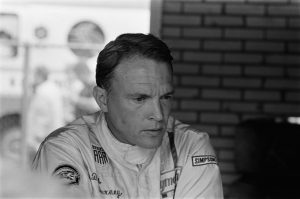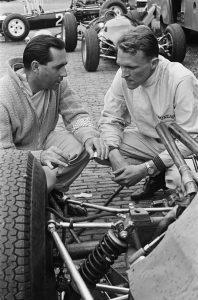
Daniel Sexton Gurney
Dan Gurney died on January 14, 2018, at age 86, and the remembrances and accolades have been pouring in.
As they should. Gurney’s name deserves to be mentioned in the same breath as those of A.J. Foyt and Mario Andretti, widely considered to be the greatest American racing drivers of all time, and by certain measures, his accomplishments exceed those of the other two.
While it is true that he never won the Daytona 500 or the Indianapolis 500, as did both Foyt and Andretti, nor the Formula One World Championship, as did Andretti, Gurney achieved success in Formula One, Indycar, NASCAR, and sportscar racing with a total of 51 wins and 47 podium finishes over a driving career shorter than those of Foyt and Andretti. He teamed with Foyt to win at LeMans for Ford in 1967. He was the first driver with victories in each of Formula One, Indycar and the NASCAR Cup series. And after retiring from the cockpit he continued his success by building race-winning cars for both Indycar and sportscar racing.
 In Formula One, he earned four points-paying victories and 18 podium finishes, but the undisputed highlight was his victory in the 1967 Belgian Grand Prix where Gurney, driving his own Eagle Gurney-Weslake V-12, became the first and so far only American to win in Formula One with a car of his own construction.
In Formula One, he earned four points-paying victories and 18 podium finishes, but the undisputed highlight was his victory in the 1967 Belgian Grand Prix where Gurney, driving his own Eagle Gurney-Weslake V-12, became the first and so far only American to win in Formula One with a car of his own construction.
In Indycar, Gurney claimed seven wins but had to settle for second place – twice – at the Indianapolis 500. Bobby Unser bested Gurney at Indy in 1968 and Mario Andretti led Gurney to the flag in 1969. But Unser’s victory came in a Gurney-built Eagle and in 1973 another Gurney-built Eagle was taken to the Indianapolis 500 winners circle by Gordon Johncock.
Gurney may have been the original “road course ringer” in NASCAR, demonstrating both his skill and versatility by dominating the NASCAR Cup-series races Riverside Raceway in California. Driving for Holman-Moody in 1963 and the Wood Brothers in 1964, 1965, 1966 and 1968, Gurney won each time. Gurney’s 1967 race at Riverside, for Bill Stroppe and crew chief Bud Moore, was spoiled by mechanical problems.
In 1966 Gurney put Ford’s GT40 Mk II on the pole for the 24 Hours of Le Mans. While the 1966 race victory would escape him, in 1967 he teamed with Foyt to drive the GT40 Mk IV to a victory that cemented his place among the greats. And it was at that race, while at the top step of the victory podium, that Gurney invented a celebration that is now de rigueur in racing – the champagne shower.
Another invention of Gurney’s is the addition of a narrow extension, called a wickerbill, to the trailing edge of the rear wing on a race car. So successful was this that the piece, still in use to this day, is often referred to as a “Gurney Flap.”
After retiring as a driver in 1970, Gurney turned his attention to his company, All American Racers, which built and prepared cars for a variety of open-wheel and sports car series. 157 Gurney Eagles were built between 1965 and 2000 for AAR’s own racing team and for customers, and the car won in the Formula One, at the Indianapolis 500, the 12 Hours of Sebring, 24 Hours of Daytona, and elsewhere. The AAR Eagle Mark III, powered by a turbocharged Toyota engine, proved so dominant in IMSA GTP competition in the early 1990s that the car is often credited with single-handedly killing the GTP class. After amassing nine wins in 13 races during the 1992 season, the AAR Eagle Mk III returned in 1993 to win every race.
 Gurney, tall, lean and handsome, is generally thought to be a native of southern California, where he lived from the beginning of his racing career through his passing. But in fact, Gurney was born in Port Jefferson, New York, and it was only after he had graduated from high school that the family moved to Riverside, California. At age 19 Gurney built a car that he raced on the Bonneville Salt Flats, before serving two years in the army as an artillery mechanic in the Korean War.
Gurney, tall, lean and handsome, is generally thought to be a native of southern California, where he lived from the beginning of his racing career through his passing. But in fact, Gurney was born in Port Jefferson, New York, and it was only after he had graduated from high school that the family moved to Riverside, California. At age 19 Gurney built a car that he raced on the Bonneville Salt Flats, before serving two years in the army as an artillery mechanic in the Korean War.
On his return from military service, Gurney took up sports car racing at the former army base Torrey Pines, near San Diego, and soon was racing with the likes of Carroll Shelby, Phil Hill, Walt Hansgen, and Masten Gregory. All five men would make their way to Europe for sportscar and Formula One and sports cars.
In 1964 Car & Driver magazine launched its “Dan Gurney for President” campaign, which was only partially tongue in cheek. By then Gurney was well-respected by racing insiders and well-loved by racing fans. In the mid-1970s, Gurney prepared what is known as the “White Paper,” a document that led to Indycar team owners forming Championship Auto Racing Teams (CART).
Of the many statements of praise and respect accorded Gurney upon his passing, two of the most heartfelt came from Foyt and Andretti. That alone should tell you what you need to know about Daniel Sexton Gurney.

